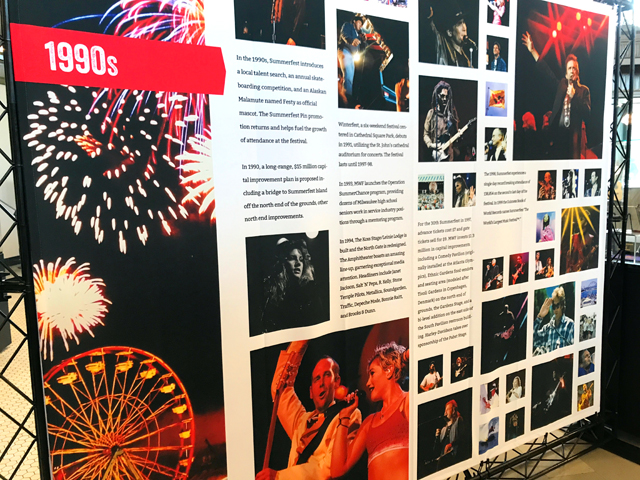While Summerfest was finding its legs in the 1970s and growing bigger and bigger in the 1980s, the following decade was more one of building on the success of the Big Gig, entrenching it deeper into the Milwaukee psyche and lore.
At the beginning of the decade, for the 1990 festival, Summerfest brought back its popular pin promotion, which had debuted at the 1970 and later been discontinued.
The pins allowed purchasers to enter the festival for free every weekday afternoon. They also became beloved collector’s items.
"I have all the pins," says Denise Tanzilo, my sister-in-law, and devoted Summerfest pin collector. "I have doubles of most – I got some doubles from friends and sales. I keep one pristine set and I wear the others. I display them on a lanyard that I wear only during Summerfest.

(PHOTO: Denise Tanzilo)
"My favorite is the old snorkel one. My second fave is the 1990 sunglasses guy. I never used to wear the gold ones. I just saved them, but that wasn’t fun, so now I wear them, too."
The pins also helped Summerfest continue to bolster its revenues, according to Dave Tianen, who wrote in his book, "Summerfest: Cooler by the Lake, 40 Years of Music and Memories:"
"Since the pins were sold in the weeks before the festival opened, they also provided Summerfest with a revenue buffer against the potential of lower attendance because of bad weather."
The program ended again in 2003.
"I was sad when they stopped," says Tanzilo. "They should start again. I have suggestions."
Promotions were a big boost for the Big Gig in the 1990s. In 1997, Tianen wrote, "a survey found that 21 percent of Summerfest attendees used some kind of discount to purchase their admission."

Johnny Cash at Summerfest during the 1990s. (PHOTO: Summerfest/Milwaukee County Historical Society)
Later in the decade, in 1998, the festival set a single-day attendance record on the penultimate day of Summerfest as 138,854 people passed through the gates. That led the Guinness Book of World Records to name Summerfest the World’s Largest Music Festival the following year. It’s a sobriquet that the festival has used ever since.
With growth came the need for improvements on the grounds, too, and the 1990s found a number of big changes at the Henry Maier Festival Park.
A $15 million capital improvements plan was proposed and four years later, Summerfest got a new North Gate, a permanent stage was built for the Koss Stage/Leinie Lodge and the Potawatomi Bingo Casino/V100 Soul Stage was launched.
In 1997, Summerfest added the Comedy Pavilion, which it shipped up from its former home at the 1996 Summer Olympics in Atlanta, the Gardens Stage and the Ethnic Gardens food and seating area near the north end.
The same year, Harley-Davidson began its sponsorship of the former Pabst Stage.
But the biggest change was just offshore.

(PHOTO: Summerfest/Milwaukee County Historical Society)
In 1991, a new 17-acre island was created by the Milwaukee Metropolitan Sewerage District, along with the City’s Board of Harbor Commissioners using limestone and granular fill from the deep tunnel project.
The new island offered a safe harbor for small boats just off the Summerfest rocks and also helped prevent erosion along the festival grounds. It also provided a great place from which to launch fireworks displays.
In 2007, it became one of two urban state parks in Milwaukee (along with Havenwoods) that has proved popular with bikers, walkers, joggers and others. It was the first new state park since 1978.

Some other interesting moments and facts from Summerfest in the 1990s...
- In 1990, Summerfest tabbed an Alaskan Malamute named Festy as its official mascot.
- In 1991, Summerfest launched Winterfest at Cathedral Square Park, with live music and more. The last installment of the event was in 1997-98.
- In 1993, Summerfest created Operation SummerChance, a mentoring program that provided work in service industry positions to Milwaukee high school seniors.
- In 1997, Summerfest celebrated its 30th anniversary. Tickets to the Big Gig this year cost $9 at the gate and $7 in advance.
Born in Brooklyn, N.Y., where he lived until he was 17, Bobby received his BA-Mass Communications from UWM in 1989 and has lived in Walker's Point, Bay View, Enderis Park, South Milwaukee and on the East Side.
He has published three non-fiction books in Italy – including one about an event in Milwaukee history, which was published in the U.S. in autumn 2010. Four more books, all about Milwaukee, have been published by The History Press.
With his most recent band, The Yell Leaders, Bobby released four LPs and had a songs featured in episodes of TV's "Party of Five" and "Dawson's Creek," and films in Japan, South America and the U.S. The Yell Leaders were named the best unsigned band in their region by VH-1 as part of its Rock Across America 1998 Tour. Most recently, the band contributed tracks to a UK vinyl/CD tribute to the Redskins and collaborated on a track with Italian novelist Enrico Remmert.
He's produced three installments of the "OMCD" series of local music compilations for OnMilwaukee.com and in 2007 produced a CD of Italian music and poetry.
In 2005, he was awarded the City of Asti's (Italy) Journalism Prize for his work focusing on that area. He has also won awards from the Milwaukee Press Club.
He has be heard on 88Nine Radio Milwaukee talking about his "Urban Spelunking" series of stories, in that station's most popular podcast.







